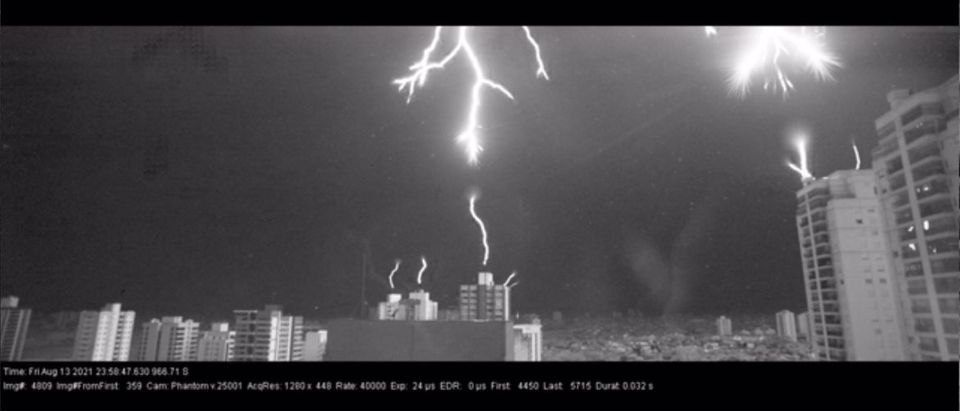Brazilian researchers used a high-speed camera to catch a rare image of a lightning strike shooting upwards.
The image is helping scientists understand how lightning rods protect buildings from strikes, reported the New York Times. The image, captured during an electrical storm in São José dos Campos, Brazil, shows the exact moment that several buildings’ lightning rods reached out to meet descending lightning bolts mid-air. (RELATED: Insane Videos Show ‘Upwards’ Lightning In Kansas City)
Benjamin Franklin invented the lightning rod in the mid-18th century, but researchers are still working to understand its function. The general idea is that a copper or aluminum rod attached to the highest point of a building will capture a lightning strike and divert the intense electrical charges away from the structure of the building by running them through wires attached to the rod underground. But the rod isn’t passive: a millisecond before lightning even strikes, the lightning’s negative charge in the atmosphere triggers the rod, which sends a positive charge upwards to connect it.
Brazilian researchers say they were lucky enough to be at the right place, at the right time to capture this event, which typically not visible to the human eye, on camera. The researchers were positioned about 150 yards away from the lightning with a camera capable of capturing up to 40,000 frames per second.
The researchers’ analysis and photos were first published in the Geophysical Research Letters journal last year, but a video that pieces those photos together now shows the lightning bolt traveling toward the ground at 230 miles per second. When the lightning was a mere hundred feet from the ground, “lightning rods and tall objects on the tops of nearby buildings produced positive upward discharges, competing to connect to the downward strike,” said Dr. Marcelo Saba, lead author of the study and researcher at Brazil’s National Space Research Institute, in a release.
“The final image prior to the connection was obtained 25 thousandths of a second before the lightning hit one of the buildings,” Dr. Saba added.
The study demonstrated the danger posed if lightning rod protection systems are not properly installed. Saba said that although 30 lightning rods were located in the image vicinity, a flaw in the installation allowed lightning to hit a smokestack, causing significant damage.
“Some salesmen say that their lightning rods are better than the rest,” Dr. Saba said. “but this is just sales talk. There is no solid research on that. There are standards that have to be followed by those installing lightning rods. That’s the best we can do for now.”


